Oldest surviving Pullman porter dies at 106 — Marshall, TX native
Lee Wesley Gibson, believed to have been the oldest living Pullman porter, died as he lived — calm, quiet and in control — sitting in a chair at home Saturday with family members at his side.
Gibson was 106 years old.
“He had just celebrated his birthday five weeks earlier and he thanked everyone,” said family friend Rosalind Stevenson.
Gibson began work as a coach attendant with Union Pacific Railroad in 1936 at the height of the Great Depression. He was later promoted to Pullman porter, one of the uniformed railway men who served first-class passengers traveling in luxurious sleeping cars. It was a much-coveted job that improved the fortunes of many struggling African Americans at the time.
During a 38-year career, Gibson traveled the country, rubbing shoulders with celebrities and taking pride in the role, though it involved long hours and occasional indignities. Porters were required to respond to the name “George” after the founder of the Pullman Palace Car Co., George Pullman.
“It was hard, but it was fun,” Gibson told The Times in a 2010 interview.
The second child of West Gibson and Annie (Pugh) Gibson, Gibson was born May 21, 1910, in Keatchie, La. After his parents separated, his mother moved with the children to Marshall, Texas, where Gibson attended New Town Elementary School and Central High School, family members said.
Read more about Mr. Gibson’s life and Pullman career here.
- Click here for more about “The Brotherhood of Sleeping Car Porters”
Slavery: The deleted passage of the Declaration of Independence
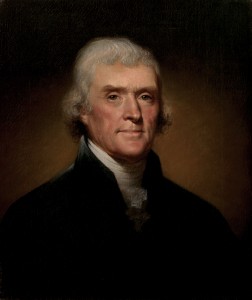 When Thomas Jefferson included a passage attacking slavery in his draft of the Declaration of Independence it initiated the most intense debate among the delegates gathered at Philadelphia in the spring and early summer of 1776. Jefferson’s passage on slavery was the most important section removed from the final document. It was replaced with a more ambiguous passage about King George’s incitement of “domestic insurrections among us.” Decades later Jefferson blamed the removal of the passage on delegates from South Carolina and Georgia and Northern delegates who represented merchants who were at the time actively involved in the Trans-Atlantic slave trade. Jefferson’s original passage on slavery appears below.
When Thomas Jefferson included a passage attacking slavery in his draft of the Declaration of Independence it initiated the most intense debate among the delegates gathered at Philadelphia in the spring and early summer of 1776. Jefferson’s passage on slavery was the most important section removed from the final document. It was replaced with a more ambiguous passage about King George’s incitement of “domestic insurrections among us.” Decades later Jefferson blamed the removal of the passage on delegates from South Carolina and Georgia and Northern delegates who represented merchants who were at the time actively involved in the Trans-Atlantic slave trade. Jefferson’s original passage on slavery appears below.
“He has waged cruel war against human nature itself, violating its most sacred rights of life and liberty in the persons of a distant people who never offended him, captivating & carrying them into slavery in another hemisphere or to incur miserable death in their transportation thither. This piratical warfare, the opprobrium of infidel powers, is the warfare of the Christian King of Great Britain. Determined to keep open a market where Men should be bought & sold, he has prostituted his negative for suppressing every legislative attempt to prohibit or restrain this execrable commerce. And that this assemblage of horrors might want no fact of distinguished die, he is now exciting those very people to rise in arms among us, and to purchase that liberty of which he has deprived them, by murdering the people on whom he has obtruded them: thus paying off former crimes committed again the Liberties of one people, with crimes which he urges them to commit against the lives of another.”
PV art professor’s exhibit — named among top five in Texas — extended to Aug. 18 in Austin

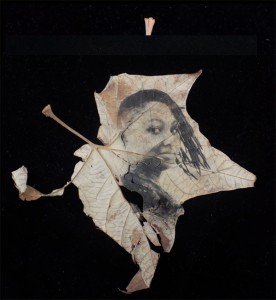 School of Architecture visiting assistant art professor Ann Johnson’s Austin solo exhibition at Women and Their Work Gallery has been extended to run through August 18. Johnson was one of 8 artists selected among 320 entries to be granted a solo exhibition. Her exhibit, “Converse: Real Talk,” challenges viewers to sit face to face and engage in a personal conversation.
School of Architecture visiting assistant art professor Ann Johnson’s Austin solo exhibition at Women and Their Work Gallery has been extended to run through August 18. Johnson was one of 8 artists selected among 320 entries to be granted a solo exhibition. Her exhibit, “Converse: Real Talk,” challenges viewers to sit face to face and engage in a personal conversation.
Johnson transitioned the art gallery into a park with white trees, and leaves, allowing the viewers to be the color of the composition. Viewers are encouraged to sit under trees and have a conversation around text that can be read in the shadows on the walls. The exhibition has been named a top five exhibition in the state of Texas by Glasstire online art magazine and has been favorably reviewed in both the Austin Chronicle, and the Austin American-Statesman.
The exhibit features Johnson’s printmaking aesthetic of printing on feathers and leaves, and a new flirtation with video and reflective printmaking. The exhibition opened on May 7. Women and Their Work Gallery is located at 1710 Lavaca St., Austin.
Princeton University’s Toni Morrison papers archive is now available to researchers
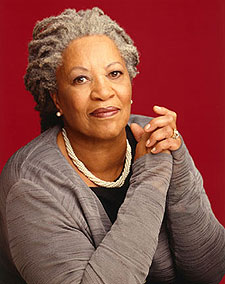 The Princeton University Library has announced that a major portion of the Toni Morrison Papers collection is now available for researchers. The papers were donated to the university in 2014. Professor Morrison is the Robert F. Goheen Professor in the Humanities Emerita and the 1993 Nobel Prize winner for literature. She joined the faculty at Princeton in 1989 and taught creative writing classes until 2006.
The Princeton University Library has announced that a major portion of the Toni Morrison Papers collection is now available for researchers. The papers were donated to the university in 2014. Professor Morrison is the Robert F. Goheen Professor in the Humanities Emerita and the 1993 Nobel Prize winner for literature. She joined the faculty at Princeton in 1989 and taught creative writing classes until 2006.
The Toni Morrison Papers include correspondence from a wide range of scholars including Maya Angelou, Houston Baker, Toni Cade Bambara, Amiri Baraka, Gwendolyn Brooks, Ossie Davis and Ruby Dee, Leon Higginbotham, Randall Kennedy, Ishmael Reed, and Alice Walker. The collection also includes unpublished plays and lectures and early handwritten drafts of the author’s novels. The drafts include editing changes that allow researchers to study Morrison’s creative process.
Tracy K. Smith, professor of creative writing at Princeton, stated that the fact that “Morrison’s papers will be made accessible is a watershed for scholars of her writing. And for writers like myself, the opportunity to track Morrison’s process as a writer and editor — to see where she saw fit to make changes, and to observe her manner of revision and reflection — will be of immeasurable value.”
Texas A&M diversity increases without affirmative action
 A surprising shift has occurred at A&M over the last decade. Despite its reluctance to formally consider the race of its applicants, the university has worked hard to convince black and Hispanic students to apply and enroll. Since 2003, when the U.S. Supreme Court reaffirmed the legality of affirmative action in college admissions, A&M has continued not using it, yet the share of black and Hispanic students has more than doubled at its College Station campus — from 10.8 percent to 23.1 percent.
A surprising shift has occurred at A&M over the last decade. Despite its reluctance to formally consider the race of its applicants, the university has worked hard to convince black and Hispanic students to apply and enroll. Since 2003, when the U.S. Supreme Court reaffirmed the legality of affirmative action in college admissions, A&M has continued not using it, yet the share of black and Hispanic students has more than doubled at its College Station campus — from 10.8 percent to 23.1 percent.
That 114 percent growth can’t simply be attributed to statewide demographic shifts. At UT-Austin, black and Hispanic enrollment has grown by 45 percent over the same time. Last fall, black and Hispanic students made up nearly the same share of the student body at A&M as UT-Austin.
A&M officials give credit to their embrace of the state’s controversial Top 10 Percent Rule, an evolution of how the school views itself and a university-wide commitment to making A&M a more welcoming place for minorities.
Read more of the Texas Tribune story here.
TIPHC Bookshelf
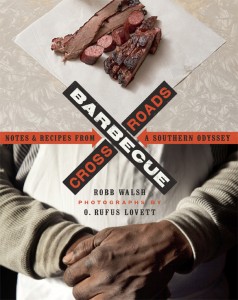 Published scholarship on black history in Texas is growing and we’d like to share with you some suggested readings, both current and past, from some of the preeminent history scholars in Texas and beyond. We invite you to take a look at our bookshelf page — including a featured selection — and check back as the list grows. A different selection will be featured each week. We welcome suggestions and reviews. This week, we offer, “Barbecue Crossroads,” by Robb Walsh.
Published scholarship on black history in Texas is growing and we’d like to share with you some suggested readings, both current and past, from some of the preeminent history scholars in Texas and beyond. We invite you to take a look at our bookshelf page — including a featured selection — and check back as the list grows. A different selection will be featured each week. We welcome suggestions and reviews. This week, we offer, “Barbecue Crossroads,” by Robb Walsh.
In stories, recipes, and photographs, James Beard Award–winning writer Robb Walsh and acclaimed documentary photographer O. Rufus Lovett take us on a barbecue odyssey from East Texas to the Carolinas and back. In Barbecue Crossroads, we meet the pitmasters who still use old-fashioned wood-fired pits, and we sample some of their succulent pork shoulders, whole hogs, savory beef, sausage, mutton, and even some barbecued baloney.
Walsh and Lovett also remind us of myriad ways that race weaves in and out of the barbecue story, from African American cooking techniques and recipes to the tastes of migrant farm workers who ate their barbecue in meat markets, gas stations, and convenience stores because they weren’t welcome in restaurants.
This Week In Texas Black History, July 3-9
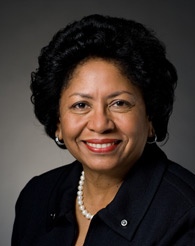 3 – Ruth J. Simmons was born on this day in 1945 in Grapeland and 56 years to the day was sworn in as the 18th president of Brown University in 2001, becoming the first black president of an Ivy League school and the first female president at Brown (founded in 1764). Simmons was the youngest of 12 children born to a sharecropper father and a mother who worked as a maid. In 1995, Simmons became the first African-American woman to head a major college or university when she was selected as president of Smith College, which she led until 2001. Simmons graduated in 1963 from Phillis Wheatley High School in Houston.
3 – Ruth J. Simmons was born on this day in 1945 in Grapeland and 56 years to the day was sworn in as the 18th president of Brown University in 2001, becoming the first black president of an Ivy League school and the first female president at Brown (founded in 1764). Simmons was the youngest of 12 children born to a sharecropper father and a mother who worked as a maid. In 1995, Simmons became the first African-American woman to head a major college or university when she was selected as president of Smith College, which she led until 2001. Simmons graduated in 1963 from Phillis Wheatley High School in Houston.
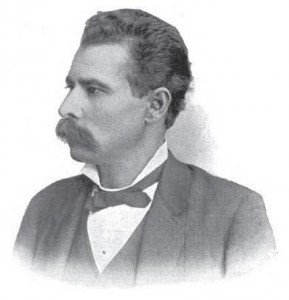 4 – On this date in 1867, the Texas Republican Party was formed at a convention in Houston with African-American delegates outnumbering whites by a total of about 150 to 20. Blacks, comprising about 90 percent of the party throughout Reconstruction, would set the foundation for the party. Forty-four black Republicans would serve in the state legislature. The second State GOP Chairman, Norris Wright Cuney, an African-American from Galveston led the Party from 1883 to 1897 and is said by historians to have held “the most important political position given to a black man of the South in the nineteenth century.”
4 – On this date in 1867, the Texas Republican Party was formed at a convention in Houston with African-American delegates outnumbering whites by a total of about 150 to 20. Blacks, comprising about 90 percent of the party throughout Reconstruction, would set the foundation for the party. Forty-four black Republicans would serve in the state legislature. The second State GOP Chairman, Norris Wright Cuney, an African-American from Galveston led the Party from 1883 to 1897 and is said by historians to have held “the most important political position given to a black man of the South in the nineteenth century.”
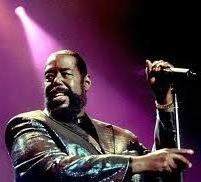 4 – On this date in 2003, R&B singer and composer Barry White, a Galveston native, died at age 58 of renal failure in Los Angeles. A five-time Grammy Award winner, White’s gravelly, seductive, bass voice earned him 106 gold and 41 platinum albums, 20 gold and 10 platinum singles, with worldwide sales in excess of $100 million. White had suffered with high blood pressure for many years and then diabetes.
4 – On this date in 2003, R&B singer and composer Barry White, a Galveston native, died at age 58 of renal failure in Los Angeles. A five-time Grammy Award winner, White’s gravelly, seductive, bass voice earned him 106 gold and 41 platinum albums, 20 gold and 10 platinum singles, with worldwide sales in excess of $100 million. White had suffered with high blood pressure for many years and then diabetes.
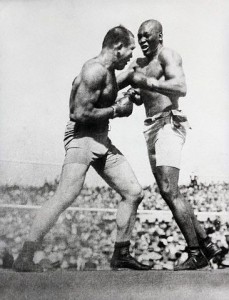 4 – In what was billed as “The Fight of the Century,” Galveston’s Jack Johnson soundly defeated Jim Jeffries, “The Great White Hope,” on this day in 1910 before a mostly white crowd of 22,000 fans in Reno, Nevada to remain as world heavyweight champion. Jeffries came out of a five-year retirement from his undefeated career to fight the racially reviled Johnson. Jeffries said, “I am going into this fight for the sole purpose of proving that a white man is better than a Negro.” Promoters incited the crowd to chant “kill the nigger.” However, the bout was scheduled for 45 rounds, but was stopped in the 15th after Johnson twice knocked Jeffries down. The outcome produced race riots in dozens of cities with some of the incidents the result of whites interrupting celebrations of jubilant blacks. Police also interrupted several attempted lynchings.
4 – In what was billed as “The Fight of the Century,” Galveston’s Jack Johnson soundly defeated Jim Jeffries, “The Great White Hope,” on this day in 1910 before a mostly white crowd of 22,000 fans in Reno, Nevada to remain as world heavyweight champion. Jeffries came out of a five-year retirement from his undefeated career to fight the racially reviled Johnson. Jeffries said, “I am going into this fight for the sole purpose of proving that a white man is better than a Negro.” Promoters incited the crowd to chant “kill the nigger.” However, the bout was scheduled for 45 rounds, but was stopped in the 15th after Johnson twice knocked Jeffries down. The outcome produced race riots in dozens of cities with some of the incidents the result of whites interrupting celebrations of jubilant blacks. Police also interrupted several attempted lynchings.
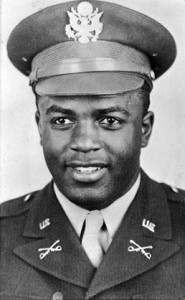 6 – In 1944, at Fort Hood Army Post in Killeen, Lt. Jackie Robinson refused to move to the back of a post bus and was taken into custody by military police, an incident that would lead to his court-martial. Three years before he would break the color line in Major League Baseball, Robinson was charged with insubordination, disturbing the peace, drunkenness (he did not drink), conduct unbecoming an officer, and refusing to obey the lawful orders of a superior officer. Robinson, serving in a support role for the all-black 761st Tank Battalion (the Army’s first such unit), would be acquitted a month later by an all-white panel of nine officers. (See, National Archives: “Jim Crow, Meet Lieutenant Robinson, A 1944 Court-Martial“, and The History Reader, “The Court Martial of Jackie Robinson.”)
6 – In 1944, at Fort Hood Army Post in Killeen, Lt. Jackie Robinson refused to move to the back of a post bus and was taken into custody by military police, an incident that would lead to his court-martial. Three years before he would break the color line in Major League Baseball, Robinson was charged with insubordination, disturbing the peace, drunkenness (he did not drink), conduct unbecoming an officer, and refusing to obey the lawful orders of a superior officer. Robinson, serving in a support role for the all-black 761st Tank Battalion (the Army’s first such unit), would be acquitted a month later by an all-white panel of nine officers. (See, National Archives: “Jim Crow, Meet Lieutenant Robinson, A 1944 Court-Martial“, and The History Reader, “The Court Martial of Jackie Robinson.”)
Blog: Ron Goodwin, author, PVAMU history professor
Ron Good  win’s bi-weekly blog appears exclusively for TIPHC/TBHPP. Goodwin is a San Antonio native and Air Force veteran. Generally, his column will address contemporary issues in the black community and how they relate to black history. He and the TIPHC/TBHPP staff welcome your comments. His latest blog is, “Independence Day.” Read it
win’s bi-weekly blog appears exclusively for TIPHC/TBHPP. Goodwin is a San Antonio native and Air Force veteran. Generally, his column will address contemporary issues in the black community and how they relate to black history. He and the TIPHC/TBHPP staff welcome your comments. His latest blog is, “Independence Day.” Read it
Submissions Wanted
Historians, scholars, students, lend us your…writings. Help us produce the most comprehensive documentation ever undertaken for the African American experience in Texas. We encourage you to contribute items about people, places, events, issues, politics/legislation, sports, entertainment, religion, etc., as general entries or essays. Our documentation is wide-ranging and diverse, and you may research and write about the subject of your interest or, to start, please consult our list of suggested biographical entries and see submission guidelines. However, all topics must be approved by TIPHC/TBHPP editors before beginning your research/writing.
We welcome your questions or comments via email or telephone – mdhurd@pvamu.edu.
